Quck answer
Shark pictures are widely used in popular culture and media to depict these fascinating creatures. They can be found in books, magazines, documentaries, and movies. Shark pictures can be both beautiful and terrifying, showcasing the diversity of species and their unique features such as sharp teeth, powerful jaws, and sleek bodies. Some popular species of sharks that are often featured in pictures include great white sharks, hammerhead sharks, tiger sharks, and bull sharks. Photographers and filmmakers often use advanced technology to capture stunning images of sharks in their natural habitats, providing a glimpse into their mysterious world.
Wildlife

Brandon Cole/Getty Images
Sharks, such as the great white, can lose up to 1,000 teeth per year. Sharks’ teeth are constantly being replaced throughout their lifetime. See a great white shark about to prey on a seal on the following page.

BBC/DCL
Great white sharks have serrated teeth for tearing through and removing pieces of meat. Curious about which shark is named after a fruit? See the next picture.

Reinhard Dirscherl/Getty Images
These lemon sharks (Negaprion brevirostris) are swimming in the Atlantic Ocean around Grand Bahama Island. In the next picture, a diver comes face to face with a shark.

Brian J. Skerry/Getty Images
Humans pose a much greater risk to sharks, such as this oceanic whitetip, than they do to us. Overfishing, finning, and habitat destruction are causing significant harm to shark populations. On the following page, see tourists in the water with a great white shark.

Sue Flood/Getty Images
This great white shark swims past a cage filled with tourists. Like the great white, the following shark is considered to be one of the most dangerous in the world.

Brian J. Skerry/Getty Images
Bull sharks can live in freshwater and have been discovered up to 60 miles upriver in warm, turbid rivers like the Amazon and Mississippi. See how to better protect yourself from a shark attack on the following page.

If you plan to swim near sharks, avoid wearing shiny jewelry as it may be mistaken for fish scales, like the shark about to attack a school of fish on the following page.
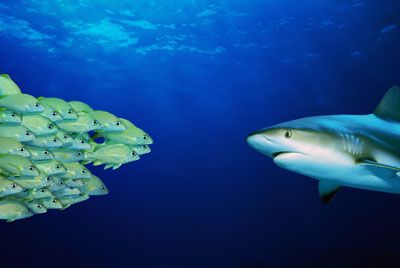
Steven Hunt/Getty Images
Some sharks, such as the Caribbean reef shark, go into a frenzied state when food is available, but they still maintain a kind of pecking order. See a shark feeding frenzy on the following page.
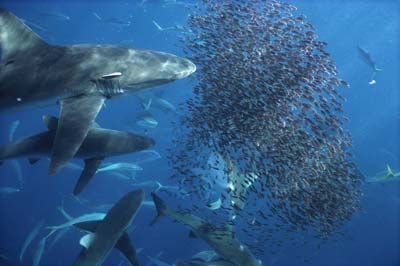
Tui De Roy/Getty Images
Bronze whaler sharks (Carcharius brachyurus) have an offshore feeding frenzy around the Galapagos Islands. Does a tiger shark have stripes? See the following picture.

В© iStockphoto/Ian Scott
The juvenile tiger shark has stripes like a tiger, although they are not visible in this picture. Get a glimpse of a hammerhead shark in the next photo.

Brian J. Skerry/Getty Images
There have only been 38 recorded hammerhead attacks on humans since 1580, only 16 of which were unprovoked, and no one has ever been killed by a hammerhead. Can sharks smell? Find out in the following picture.

Norbert Wu/Science Faction/Getty Images
Some sharks have a sense of smell sensitive enough to detect one drop of blood in an Olympic-sized swimming pool. The sharks in the following picture are commonly found around reefs.

Brandon Cole/Getty Images
Atlantic nurse sharks are frequently seen on Caribbean reefs. The next shark is typically shy around divers, except when baited.

Brandon Cole/Getty Images
Sharks don’t eat like humans, as they don’t chew their food. If a shark can fit its prey in its mouth, it will swallow it whole. Check out another shark species found in the Indian Ocean on the following page.
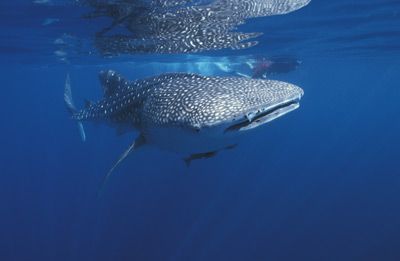
Brandon Cole/Getty Images
Whale sharks have a mouth that can be as wide as six and a half feet, but they mostly feed on tiny plankton. You can spot the next shark species near the Hawaiian coast.

David Wrobel
White-tipped reef sharks are commonly found in the tropical Indo-Pacific region. It’s best to avoid them as they tend to be aggressive by nature. The next shark species has six gills, take a look.

Brandon Cole/Getty Images
The sixgill shark is usually found in deeper waters. You can find a full-length silvertip shark on the next page.

Brandon Cole/Getty Images
Compared to the great white shark on the next page, silvertip sharks are a lesser threat to divers.
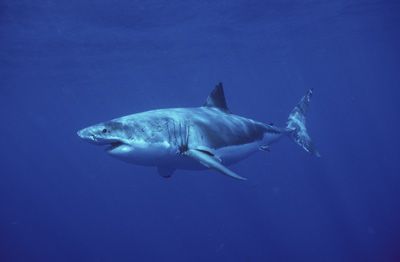
Brandon Cole/Getty Images
Less than 5% of sharks are the size of giants like the great white. The following pictures showcase nurse sharks.
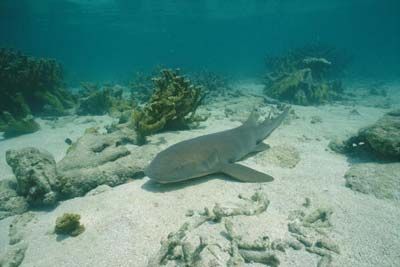
Wolcott Henry/National Geographic/Getty Images
The nurse shark is often seen resting motionless on the bottom, as they can pump water over their gills.

Wolcott Henry/Discovery Channel Images/Getty Images
This nurse shark is waiting for its prey to swim by. In the last 500 years, there have only been 49 reported incidents of nurse shark attacks.

iStockphoto/Jess Wiberg
The nurse shark is a generally harmless species, but people often try to handle them, resulting in bites.
FAQ
1. What are some interesting facts about sharks?
Sharks are fascinating creatures that have been around for over 400 million years. Some interesting facts about them include their ability to detect electrical fields, their incredible sense of smell, and their ability to go into a state of “tonic immobility” when turned upside down. Additionally, some species of sharks can swim at speeds of up to 60 miles per hour.
2. What are some common misconceptions about sharks?
Unfortunately, many people have misconceptions about sharks that are simply not true. For example, not all sharks are man-eaters, and most species of sharks are not a threat to humans. Additionally, sharks do not actively seek out humans as prey, and attacks on humans are often a case of mistaken identity or a defensive response.
3. What are some of the different species of sharks?
There are over 400 different species of sharks, each with their own unique characteristics and behaviors. Some of the most well-known species include the great white shark, tiger shark, hammerhead shark, and bull shark.
4. How do sharks reproduce?
Sharks reproduce in a variety of ways, but most species are oviparous (lay eggs) or viviparous (give birth to live young). Some female sharks can carry their eggs inside of them for up to two years before giving birth.
5. Are sharks endangered?
Many species of sharks are currently threatened or endangered due to overfishing, habitat loss, and other human activities. It is important that we take steps to protect these important predators and ensure their survival for future generations.
6. What role do sharks play in the ecosystem?
Sharks play a vital role in maintaining the balance of the ocean ecosystem. As apex predators, they help to regulate the populations of other marine animals and keep the food chain in check. Without sharks, the ocean ecosystem would be drastically altered.
7. How do scientists study sharks?
There are a variety of ways that scientists study sharks, including tagging and tracking them, collecting tissue samples for DNA analysis, and using underwater cameras to observe their behavior. Some researchers also study shark fossils to learn more about their evolutionary history.
8. What are some of the threats facing sharks?
Sharks face a number of threats, including overfishing, bycatch, habitat destruction, and climate change. Additionally, some species are targeted for their fins, which are used to make shark fin soup.
9. How can we protect sharks?
There are several ways that we can protect sharks, including supporting sustainable fishing practices, reducing our use of single-use plastics, and advocating for the creation of marine protected areas. Additionally, we can educate others about the importance of sharks and their role in the ocean ecosystem.
10. Are there any benefits to shark populations?
Yes, healthy shark populations can have a number of benefits, including increased biodiversity, healthier fish populations, and a more balanced ecosystem. Additionally, sharks can be important in ecotourism, providing economic benefits to coastal communities that rely on tourism.
11. Where can I see pictures of sharks?
There are many websites and social media accounts that feature photographs of sharks, including National Geographic, Discovery Channel, and Ocean Conservancy. Additionally, many aquariums and zoos around the world have exhibits featuring live sharks and other marine animals.





Leave a Reply